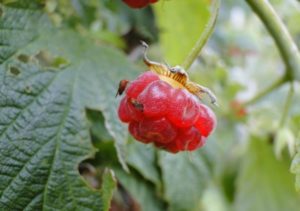
Spotted wing drosophila adults on raspberry. Photo: Hannah Burrack, North Carolina State University, Bugwood.org.
As pests go, spotted wing drosophila (SWD) is a relatively new one in mainland North America. While it was well known in Hawaii, SWD was first discovered in mainland North America in California in 2008. A year later it was found in the Pacific Northwest in Washington, Oregon and British Columbia. It has moved east since then, to Florida, the Carolinas, Michigan and other states.
SWD (Drosophila suzukii) is related to the common fruit fly (Drosophila melanogaster), which is normally an annoying, yet harmless, pest that feeds on decaying fruits and vegetables. SWD is much more serious; it feeds on developing fruit while it is still on the plant, including, but not limited to, cherries, peaches, nectarines, grapes, strawberries, blueberries, plums and raspberries.
Females lay their eggs on the fruit, which at first causes a sunken spot. As the larvae grow within the fruit, they cut a breathing hole, which causes further damage and decay and renders the fruit unmarketable.
Murray Isman, Ph.D., professor of entomology and toxicology at the University of British Columbia, has worked extensively on plant essential oils and the behavioral and physiological effects of these oils on insects. Many plants produce defensive chemicals, and some have been developed into crop protection products. Isman answers some frequently asked questions and discusses where botanical oils, such as those derived from plants such as rosemary and mint, fit into a SWD control program.
When is the right time to start scouting for SWD?
MI: Once the flies get on the fruit and lay their eggs, it’s too late in the day to do anything. So growers are interested in various strategies to intercept the flies before they get onto the fruit. Active monitoring is essential to see when or if the flies emerge in your fields. Traps baited with apple cider vinegar are very attractive to the flies and are an excellent way to monitor population levels. Traps should be placed in orchards or fields well before the fruit begins to ripen and if any SWD are seen, controls should be applied.
A central tenet of good integrated pest management is monitoring pest populations and only intervening when it’s necessary. I don’t advocate routinely spraying an insecticide or botanical oil unless you have good evidence that you need to.

Male spotted wing drosophila. Photo: Judy Gallagher
MI: It’s not a given that you’re going to have the same problem or the same intensity of a problem year after year. In my part of the world, which is a major producer of highbush blueberries, cranberries, and to a lesser extent, raspberries, 2015 was a pretty serious year for SWD. A lot of growers were becoming really concerned. But in 2016 there were very few reports of problems at all. It just wasn’t around.
It saves money and is better for the environment if you monitor for SWD and use chemical controls only when necessary.
If you do see SWD in your traps, what are your recommendations for control?
MI: There’s no doubt that products coming out of the big, multinational corporations are very, very effective. But there are a lot of question marks around organophosphates, carbamates and neonicotinoids, such as farm worker health. Even neonicotinoids, which are the latest wave in synthetics, were going to be the next big solution, but now because of the concern with bees and other pollinators, regulators are putting pretty severe limits on how they can be used.
There is a place for the botanical oils in SWD control for a number of reasons. Two years ago, we did some research on SWD and oils – in both the lab and the field – that showed quite good repellant activity. SWD seems to be inherently tolerant of the insecticidal activity of botanical oils, but they do excellent job of keeping the flies from laying eggs on the fruit.
In British Columbia, blueberries and blackberries are really getting hammered with SWD; our field researcher was getting more than 90% reductions in populations by spraying Ecotrol, which contains rosemary and peppermint oil, as an egg-laying deterrent. It seems to really push the flies away, which is pretty exciting and could be equally as good as killing them.
Since botanical oils are exempt from maximum residue levels, and there is no postharvest interval or worker reentry interval, they fit well into a program where these issues are a concern. Botanical oils also offer another important option in preventing development of resistance in these pests, because they have a different mode of action from the traditional chemistries out there.
There has also been work done with bait crops – planting raspberries, for example, around your field to attract the SWD to them instead of your main crop of blueberries. The flies are attracted to fruit when it starts to turn color, which is generally when fruit starts to soften and expand; it’s probably easier for the insect to penetrate. We know they are especially attracted to the color red, so a bait crop of raspberries can be quite effective.
What is the outlook for SWD, in your opinion?
MI: Research is ongoing into learning more about the biology and behavior of this pest, because it is relatively new in this area. As I mentioned before, there is a lot of emphasis on IPM and behavior modification. I think we will see more and more effective monitoring and using trap crops. Scientists are trying to identify what the alternative hosts are for SWD, how the flies are overwintering and where they are coming from. The more we learn about the basic biology of SWD, the better the chances of interceding before they become a real problem
